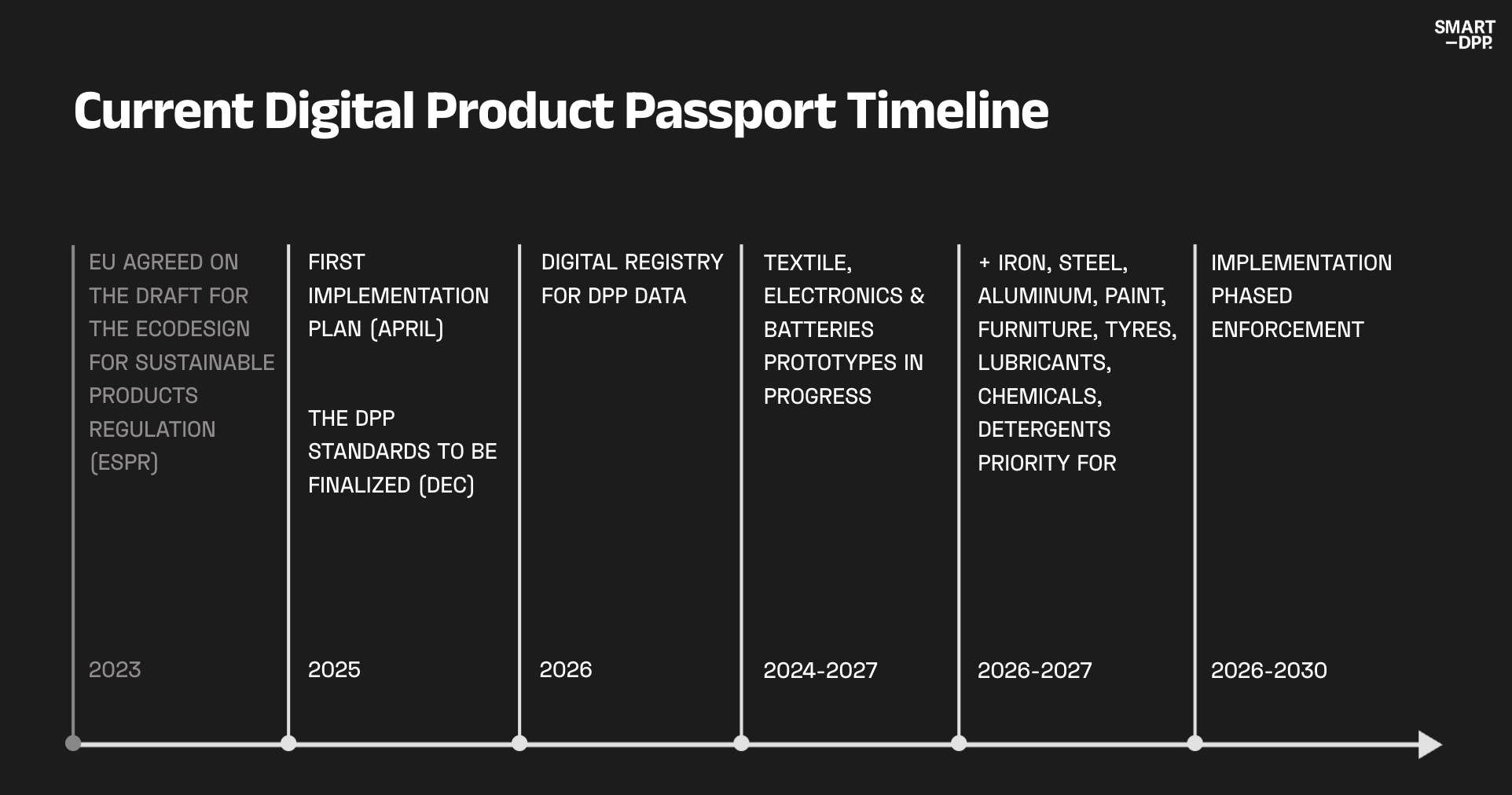Over the past year, we’ve worked with dozens of fashion brands across luxury, streetwear, emerging labels, and heritage houses. Some brands came to meet regulatory requirements. Others came to build loyalty, educate their audience, or stand out through sustainability. What we’ve learned is consistent:
The most successful brands treat DPPs as a tool for connection, not just compliance.
So, whether you’re a head of product, a sustainability lead, or a founder juggling everything—we’ve compiled what you really need to know in 2025.
1. The EU’s DPP regulation is coming—and it’s real
The Ecodesign for Sustainable Products Regulation (ESPR) is now in effect. Starting in 2027, Digital Product Passports will be mandatory for textiles and footwear. That’s just two fashion cycles away.
Despite this, many brands are still unprepared. In a recent survey, 78% of fashion businesses hadn’t mapped out their compliance timeline.

DPPs will be required to sell within the EU. The earlier you begin, the smoother the transition will be.
2. You likely already have most of the data you need
Surprise: most of the product and supply chain data needed for a DPP already lives in your ERP, PIM, or Shopify backend. You just need a smart way to structure it, map it, and publish it in the required format.
That’s exactly what SmartDPP does—so you’re not starting from scratch.
3. There’s no single DPP format—but alignment is emerging
The EU hasn’t published a single DPP template. Instead, it sets data categories: product origin, composition, care, and end-of-life details, among others. DPPs must follow interoperable and machine-readable standards. SmartDPP stays aligned with CIRPASS's community of practice to ensure whatever you build today remains functional tomorrow.
Think of DPPs like websites in the early internet era: flexible formats, but shared foundations.
4. DPPs serve regulators—and your customers too
We’ve seen brands use passports to embed videos from their ateliers, provide care and repair advice, collect emails at events via QR codes, display material-level impact data, and even offer virtual try-ons and styling inspiration.
A regulatory requirement becomes an opportunity to engage and educate.
5. QR codes are just the beginning
Most brands begin with a simple QR code on product tags. But there are other options, including NFC chips inside labels, collars, buttons on web product pages, packaging inserts, and even event showroom mirrors, or keychains.
SmartDPP supports them all, so you can choose the method that suits your collection.

6. Waiting for “perfect” data delays progress
A DPP is a living document. You can launch with the data you have and update it over time as your supply chain becomes more transparent.
We’ve seen brands move twice as fast when they begin with a handful of verified data points instead of waiting for a complete LCA.
7. DPPs prepare you for audits and future regulation
As sustainability regulations expand—from The EU Deforestation Regulation to the Green Claims Directive—having a digital passport makes documentation easier.
It becomes a timestamped source of truth that includes supplier certifications, origin details, and sustainability index, all in one place.
8. The best DPPs tell a story, not just specs
Passports guide your customers through the lifecycle of a product—origin → design → care → impact → future.
Your DPP can feel like a digital zine—one that travels with the product and builds connections long after purchase. As designer Jennifer Droguett from Anciela put it, “It’s about going back to the beginning of the garment’s journey, so you can see everything from where the fibre is coming from, materials, certifications, suppliers, and even how the garment was made.”
9. Yes, customers actually scan—when you give them a reason
We’ve seen scan rates increase significantly when brands make the experience feel special. Offering exclusive discounts, including a handwritten note prompting the scan, or embedding NFC into elegant packaging can all increase engagement.
SmartDPP tracks interactions, helping you understand what resonates.
10. You’re not behind—you’re early
Getting started may feel overwhelming, but now is the best time to test and explore.
We’re offering free pilot projects with five Digital Product Passports tailored to your brand. You’ll get everything you need:
- A full setup with QR or NFC delivery
- Templates aligned with compliance requirements
- Tools to create customer-facing stories
- Personalised guidance throughout the process
Let’s build your first DPPs together. Apply for a free pilot




